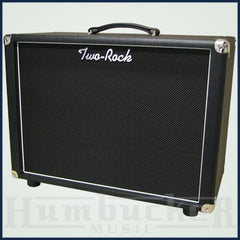A closer look at guitar cabs.
 Bigger Is Not Always Better
Bigger Is Not Always BetterThere's always the natural tendency with almost anything to assume that there is an inherent benefit to "going a little bigger." Here in the states, we would argue that it is practically in our blood :). With that being said, larger may not always be better when it comes to cabs, depending on your needs. A common misconception that we run into quite a bit is that larger cabs are louder than smaller cabs, when in reality that may not necessarily always be the case. An important point to consider is that more speakers does not always mean louder. What you do gain with more speakers is more speaker cone surface area, and in theory, the ability to move more air. Many other factors are going to have just as large of an impact as the number of speakers. Here are a few points to also consider:
- Speaker efficiency- Not all speakers are created equally when it comes to how efficiently they convert the electrical current into kinetic energy (cone movement) and produce sound. Speaker technology has come a long way in the last 100 years; with huge advancements in both materials and design, loudspeakers can now be built with extreme efficiency compared to previous designs.
- Power- A guitar cabinet is not actually where the power comes from, but rather a means to convert that power into sound. The design of the amp itself is really going to have the largest impact on how loud an amp is. It is better to think about the cab more as a delivery device, which is still very important in the grand scheme of things, but only in conjunction with the amp that is driving it.
Divide Your Forces?
One thing to consider when you opt for a larger cab (more speakers) over a smaller cab (less speakers) is that you now have split the power into smaller "shares" as it relates to how much power each speaker is getting. This can be a good thing or a bad thing depending on what exactly you're trying to achieve. With the power from the amp split among 4 speakers rather than say 2, each speaker is going to be given less power and in turn will not be driven as hard. Some of the tone of an amp comes from the way that a speaker is driven. Just like any good tube amp, speakers have a range in which they sound their best, and sometimes you have to push them a bit to get the most out of them. Driving the speakers is a bit easier when the power from the amp as a whole is not divided between as many speakers. This is an important consideration when you are trying to decide which cab is best for your needs.
Looks Often Do Not Tell the Whole Story
In our experience, from a composition standpoint, the vast majority of guitar cabs are pretty similar and the design remains pretty consistent from one to the next. Most cabs on a very basic level consist of a wooden box with a speaker mounted on a flat baffle. This has been the same basic recipe for a long time and it works very well, so it is hard to say that one cab's construction can be better than the next. With that being said, there are a few manufacturers that have tweaked the design in one way or another and the cabs that they produce bring a bit more to the table in the way of performance and flexibility than the basic design. One major feature that is dicussed quite a bit when dealing with cabs is "open back" versus "closed back" Here is a general overview of the differences:
- "Open back" - With this type of design, the back of the cabinet is not completely sealed. Often a large section of the back baffle is open, exposing the back of the speaker. Since the cab is not completely sealed, air is able to travel in and out freely, and as a result, the speaker cone can also travel backward and forward with little resistance from any type of air pressure/vacuum. With the speaker cone traveling freely when triggered, the tone produced tends to have a loose, "airy" quality as compared to closed back cabs.
- "Closed back" - With this style of design, the back of a cabinet is sealed, in that the back baffle is typically one solid piece. Being that air can't freely travel in and out of the cab, the pressure it creates has an impact on the speaker itself and the tone that it produces. As the speaker cone moves in and out, it will encounter resistance either in the form of back pressure as the cone retracts, or a vacuum as the speaker cone extends. This restriction in the speaker cone movement tends to give closed back cabs a punchier, more focused character than their open back counterparts.
It's hard to say that one design is really better than the next, as the needs of each player are going to be different. One manufacturer that has uniquely tackled this issue is Dr. Z. His 1x12 and 2x10 cabs feature baffles that can be easily removed, which offers the player the choice of either running the cab open or closed back, depending on the tone that they are looking for. This really adds a flexibility to the tone of the cabs.
CLICK HERE to check out the Dr. Z 1x12 / 2x10 cabs.
Thinking Outside the Box
Another way that Dr.Z has cleverly integrated technology into the standard cab design is with the creation of the Z-Best cab. Out of all the cabs that we sell, this cab employs the most science, and customers have raved about its performance over the years. Here are a few things that make the Z-Best pretty unique:
- Advanced Porting - Porting is basically removing material from the speaker baffle in order to manipulate the way that air and sound travels in and out of the cab while the cab is in use. With porting, you get basically the best attributes of both closed and open back cabs. The benefits are the most apparent in the bass response of the cab. The Z-Best has one of the most powerful bass responses on the market, and even though it is a 2x12 cab, it moves every bit as much air as most 4x12's due to its porting.
- Tuning - Where most cabs have baffles that are pretty much just one solid piece of wood, the Z-Best actually has "shelves" built into the speaker baffle. The purpose of these shelves is to be able to actually "tune" the cab. By manipulating the depth and thickness of the shelves, Dr. Z is able to optimize the frequency response of the cab. The shelves are actually able to block undesirable frequencies, as well as augment the more musical ones.
- Mixed Speakers - The Z-Best comes stock with one Celestion Vintage 30 and one G12H30. This combination of speakers covers a very wide range of tones, as each has a bit different personality. By pairing them together, Dr. Z has produced a cab with a much wider range than most cabs which contain multiples of the same speaker. It is also probably worth mentioning the cab itself was designed for optimum performance with this particular speaker combination.
CLICK HERE for more information on the Dr. Z Z-Best.
Here are a few links to some of the cabinet brands that we carry:




